
PREV ARTICLE
NEXT ARTICLE
FULL ISSUE
PREV FULL ISSUE
MORE ON SPMC'S OBSOLETE BANKNOTE DATABASEThe September/October 2017 issue of Paper Money (Official publication of the Society of Paper Money Collectors), included a review of SPMC's Obsoletes Database
Project, web site where members can share information and images about obsolete U.S. paper money. Author (and SPMC President) Shawn Hewitt kindly shared the article for publication of an excerpt
here. Thanks!
An article in the July/August 2017 issue gave an overview of the project, which has been underway for three years. -Editor In the previous edition of Paper Money we gave you the 30,000 foot view of the Obsoletes Database Project (ODP) found at www.spmc.org/obs/. Here we’ll get much closer to the ground, so hang on as we come in for a landing. Before we get too far along I’d like you to check out the home page. Consider this to be a good starting point if you ever get lost. From here you can get to nearly any page on the website, via direct link or the Search utility. As ODP is an SPMC membership benefit, you need to be logged in to get past the home page. In addition to the “above the fold” area on the home page, you’ll see sections for Featured Notes (which are notes deemed worthy in some way by our State Experts (SEs)), Unidentified Notes (which users can help identify), and finally Recently Added Notes. The latter should change frequently as SEs post new notes to the database.  Organizational Overview At the highest level, there is the Issuer, whose name or title appears on the note. The Issuer has a few core descriptive pieces of information about it, like its title, place of issue (state, city), business character (genuine, fraudulent) and dates of operation. Sub-categorical to the Issuer are the Designs of notes it has issued. Designs can be assigned based on obvious or subtle differences, for example, the presence of an overprint. If you’re on the Issuer home page, you’ll see a tab that says “Reported Designs”. Click on that to see what Designs have been reported for that Issuer. Each of the Designs is summarized in a graphical box we call a widget. Click on one to drill into the Design page. Designs have a great many attributes. Among these are Denomination, Design Type (Bank Note, Scrip, College Currency, etc.), Authenticity (Genuine, Counterfeit, Spurious, etc.), Serial Number Type (Handwritten, Printed), Protector (Overprint, Tint), Protector Color, Dimensions (if not standard bank note size), Printer, Design Details and more. At the bottom echelon of this hierarchy are the notes themselves. When on the Design page, you’ll see a tab for “Reported Notes”, which will take you a page showing a widget for each of the reported notes. Clicking on one of these will take you its Note page. This includes an image of the particular note, its grade, serial number, etc. One of these notes is designated as the plate note, the one that best represents its design. Additional note information can include its Provenance. Users can claim a note as theirs, and thereby track their collection through the Set Registry, which we will discuss later. For hoard notes, like remainders on the Canal Bank, we can set the Census Count to some large number, so we don’t have the need for duplicate entries of identical notes. Notice when on a Note page, you’ll see a trail of links near the top, called breadcrumbs, which show you where you are in the hierarchy. You can easily navigate to the higher tiers through those links.  Catalog and IDN Numbers • Issuer page: www.spmc.org/obs/i-68 As a longtime paper money collector and bibliophile, I have a long shelf of great books on obsolete paper money, including most of the SPMC publications. But the amount of
information compiled by researchers it stretching the limits of printed publications, requiring multiple thick volumes. The SPMC's effort is still young, but holds great promise for the
future.
For more information on the project, contact Shawn Hewitt at shawn@shawnhewitt.com -Editor For more information on the Society of Paper Money Collectors, see: www.spmc.org To read the earlier E-Sylum article, see:  Wayne Homren, Editor The Numismatic Bibliomania Society is a non-profit organization promoting numismatic literature. See our web site at coinbooks.org. To submit items for publication in The E-Sylum, write to the Editor at this address: whomren@gmail.com To subscribe go to: https://my.binhost.com/lists/listinfo/esylum All Rights Reserved. NBS Home Page Contact the NBS webmaster 
|